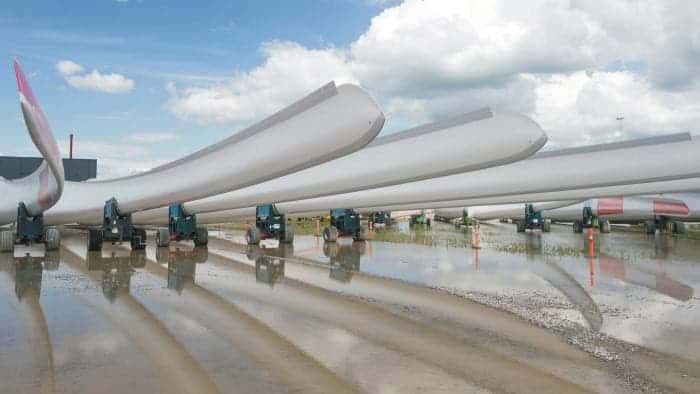
While up to 85% of a wind turbine’s parts can be recycled, its blades have remained a constant thorn in the industry’s side. While that remaining 15% might not seem like a big deal, it’s worth remembering that wind turbines are behemoths, whose blades measure at least 40 meters nowadays and can weigh seven tones. We expect thousands of wind turbines to be decommissioned over the next few decades, so that translates to a lot of waste destined for landfills.
Although these blades are non-toxic and, technically speaking, safe for landfills, the lack of recycling options is seen as inherently incompatible with the wind industry’s commitment to sustainability and full circularity.
But all that may change for the better. This week, Siemens Games, one of the world’s leading wind turbine manufacturers, announced “the world’s first recyclable wind turbine blades ready for commercial use offshore,” an exciting move that may finally transition turbines close to 100% sustainability.

The company’s product, aptly dubbed RecyclableBlades, measures 81 meters (266 feet) in length and is made of composite lightweight materials cast together with a special resin. Once the blades are ready to be decommissioned at the end of their lifecycle, the resin can be separated from the components thanks to its specially designed chemical structure.
“This mild process protects the properties of the materials in the blade, in contrast to other existing ways of recycling conventional wind turbine blades,” according to a press release from Siemens Gamesa.
The first operating RecyclabeBlades are scheduled to be installed at the Kaski offshore wind power plant in Germany, a joint project with RWE Renewables that is excepted to be completed from 2022 onwards. The first six ReyclableBlades have already been manufactured at a factory in Aalborg, Denmark.
Conventional turbine blades are typically made out of a combination of balsa wood, carbon fiber, and glass, bound together by stiff resin. However, this glue is too powerful for its own good, and separating the components is very costly — to the point that isn’t economically feasible to do so.
Many wind turbines currently operating in Europe and elsewhere across the world are part of the first generation that was installed in the 1990s, and are now nearing the end of their lifetime. By 2030, as many as 6,000 individual wind turbines per year could be decommissioned, resulting in massive blade graveyards.
There’s not all that much we can do about these old blades. In some cases, they can be reused for new projects, but this is only viable for a small fraction of turbines. New technologies, such as those pioneered by Spanish startup Reciclalia, which eliminates organic matter and separates the glass and carbon fibers, are also useful.
By the end of this year, Reciclalia claims it will be able to recycle 1,500 blades a year. That’s actually pretty good, but going forward the next generation of recyclable blades will make this process a lot easier, cheaper, and hopefully cover close to 100% of newly installed wind energy projects.
Once separated from the composite material, the RecyclableBlades components won’t be suitable for new wind turbine blades as they won’t be able to withstand typhoon conditions. Instead, their technical and physical properties will make them suitable for the auto and boat industry, or even for consumer goods.
Based on estimates of new offshore wind projects, Siemens Games expects that more than 200,000 blades could now be recyclable until 2050. Other companies will likely follow suit. Vestas, another leading wind turbine manufacturer, said it aims to produce “zero-waste” turbines by 2040, while GE Renewable Energy recently signed a deal to recycle blades from onshore wind projects in the United States.


